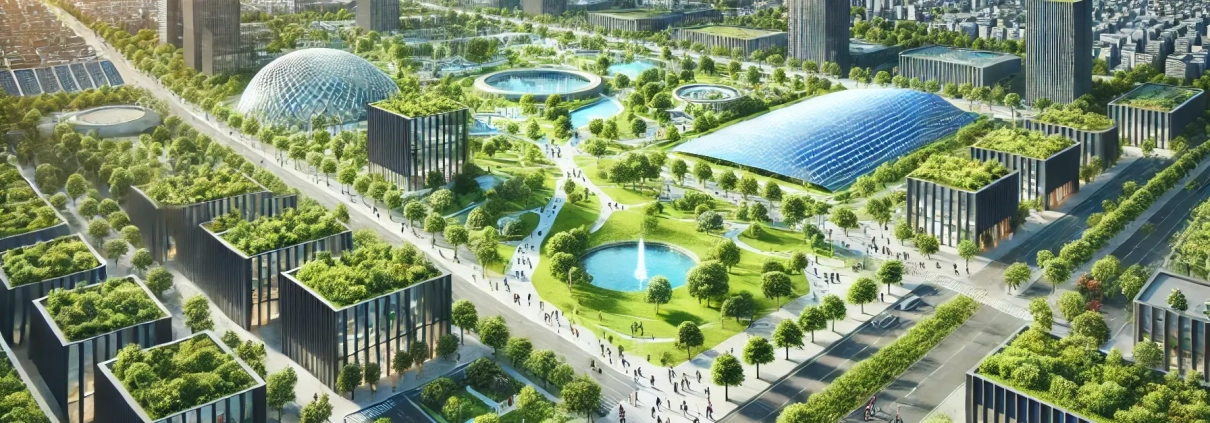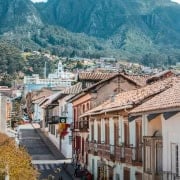A.CRE at the Smart City Expo Bogotá 2024
A year ago, my A.CRE colleague Arturo Parada and I attended our first real estate event in Bogotá, Smart City Expo Bogotá 2023, where we had the opportunity to connect with industry leaders and explore emerging trends in urban development and technology. During this first experience at the Smart City Expo, we witnessed firsthand the rapid growth of smart cities in Latin America, an approach that continues to be promoted in the 2024 edition with a renewed focus on technological innovation and real estate sustainability.
On this occasion earlier this year, September 25 to 27, the Smart City Expo 2024 was held again in Bogotá, Colombia, focused on innovative solutions poised to shape the cities of tomorrow. This event allowed us to understand from different points of view the role of technology, entrepreneurship and urban policies as key drivers for the sustainable development of cities in Latin America. A.CRE was present, actively listening to discussions about the urban future, and reaffirming our commitment to innovation in the real estate sector.
I take this opportunity to invite you to join our LinkedIn to connect with real estate professionals, share ideas on financial models and stay on top of the latest real estate trends. Join the conversation here.
At Smart City 2024, the topics addressed and most discussed were the role of technology, entrepreneurship and urban policies as key drivers for the sustainable development of cities in Latin America. According to CELAC, the region faces great challenges in terms of urbanization and economic growth, and it has been recognized that “technological innovation, combined with effective public policies, is essential to transform traditional urban models into more sustainable and equitable ecosystems.” In this sense, startups and entrepreneurship initiatives play a crucial role, as they provide innovative solutions to improve urban infrastructure, generate employment and reduce social inequalities in cities. By adopting a technology-based approach, Latin American cities can better integrate sustainability into their urban policies and more effectively address the effects of climate change, population expansion, and economic inequality.
Smart City 2024: Urban Development and Sustainability as a Goal
At the Smart City Expo 2024, it was clear that sustainable urban development is the main goal for cities in Latin America. But equally, we should not be surprised that, in the region, great importance is given to the preservation of its natural resources and green spaces. Latin America is home to approximately 50% of the world’s biodiversity and more than 25% of the planet’s forests, which is why countries always take this type of initiative for the sake of environmental conservation. In addition, more than 30% of the world’s water resources are located in this region, underscoring its relevance in terms of global sustainability. Several countries, including Brazil, Colombia, and Mexico, are implementing nature-based solutions to restore degraded lands and protect critical habitats.
In terms of protected areas, Latin America has more than 8.8 million km² in terrestrial and marine protected areas, which represents around the 21% of the region. This shows the commitment of Latin American countries to the protection of their biodiversity and vital ecosystems, but it also does not help to understand the challenges that may arise when tackling large-scale projects in the region (IUCN).
The transformation of urban communities involves a balance between technological innovation, adaptive public policies and community participation. Bogota, as a regional benchmark, demonstrates how smart governance and the strategic use of innovation districts can catalyze economic growth and improve quality of life.
Smart City Expo 2024: Innovation in the public sector
On the other hand, it is evident that the public sector and governments have a very active and influential participation in Latin American urban development, which is why public innovation is essential to generate more inclusive and resilient cities, where technology is used to strengthen government tasks within their capacities, increase transparency and guarantee the efficiency of public services.
This involves not only modernizing infrastructure, but also promoting a culture of collaboration between the private sector, civil society, and academic institutions. As an example, Bogotá has advanced in creating reliable public spaces that prioritize citizen participation and community empowerment, fostering coexistence and safety
Are you interested in innovation and technology in real estate? How do you envision the commercial real estate market in the future? Don’t miss the opportunity to read my installment: Innovation in Real Estate: Exploring Tokenization in Commercial Real Estate
Innovation Districts in Bogotá: Urban and Social Transformation
Innovation districts, as platforms for social and economic development, are positioning themselves as engines of change. These ecosystems favor the transfer of knowledge and technology, while attracting talent and investment, transforming the urban ecosystem into more sustainable and equitable spaces.
Bogotá has managed to make significant progress in the creation of Innovation districts, consolidating its position as a center of knowledge and technology in the region. One of the most outstanding projects in this regard is the Science, Technology and Innovation Campus of Bogotá (CTIB), which seeks to be a key node for the articulation between academia, the private sector and the government, promoting the creation of a dynamic innovation ecosystem.
This type of ecosystem has a strong impact on socio-economic development, as it not only improves productivity and competitiveness, but can also generate collateral effects such as gentrification and increased inequality if the associated challenges are not properly managed. Bogota is working to mitigate these risks by creating inclusive and participatory public policies, ensuring that the benefits of the innovation district reach all sectors of society
Case Studies
- “Alameda El Porvenir” Project: This is a public space located in the southwest of Bogotá, which has been an example of how citizen participation can transform urban areas. The Alameda El Porvenir is a pedestrian road of more than 17 km, which connects several neighborhoods with parks, schools and health centers. The project was developed with the participation of the local community, who were consulted during the planning and design process. Through workshops and work tables, the inhabitants expressed their needs, which allowed the design of the Alameda to include recreational areas, sports spaces and safe green areas. As a result, coexistence has improved, reducing crime rates and encouraging the use of public space by citizens.
- “Barrios de Paz” Program: This is another program that focuses on the rehabilitation of vulnerable urban areas through community empowerment and citizen participation. Through the recovery of public spaces such as parks and squares, the project seeks to reduce violence and improve the quality of life in areas affected by urban and social conflict. The key to the success of the program is the integration of the neighbors in decision-making and in the execution of the works. An outstanding example is the intervention in the Ciudad Bolívar neighborhood, where improvements were made in urban infrastructure, lighting and security, with the active participation of young people from the neighborhood in cultural and sports activities, which helped to improve coexistence and reduce conflicts.
If you want to expand your knowledge and generate your own real estate projects with hypothetical case studies, I invite you to try our tool Real Estate Case Study Creator Assistant – GPT Customized by A.CRE
Smart Cities in Action: Sustainable Strategies in the Face of Climate Change
As we have already discussed during this article, the concept of Smart Cities is intimately related to sustainability, as it allows cities to face the challenges of climate change through the integration of green technologies and multisectoral collaborations. According to the World Bank, cities are home to more than 50% of the world’s population and generate approximately 70% of greenhouse gas emissions. This makes them key players in the fight against climate change and the promotion of new eco-friendly initiatives.
In this context, the implementation of green infrastructure, such as rain gardens, sustainable drainage systems and green spaces, contributes to reducing flood risks, improving air quality and increasing biodiversity, which is why real estate developers must seek to be at the forefront in terms of implementing this type of mechanism within their projects to stand out in the sector. In addition, this type of intervention not only improves the urban environment, but also strengthens cities in the face of extreme weather events.
For many of today’s real estate projects, the integration of renewable energy and sustainable technologies not only reduces the carbon footprint, but also increases the value of assets and improves the quality of life for residents. Studies show that sustainable constructions can reduce long-term operating costs by up to 20% and increase the resale value of properties (World Bank). This highlights the importance of sustainability in large existing real estate developments, not only because of the environmental impact, but also because of the economic benefits it offers.
In the city of Bogotá, these projects are also aligned with the Sustainable Development Goals (SDGs) and the New Urban Agenda, which prioritize inclusive and collaborative planning to address issues such as inequality and access to basic services. The revitalization of urban areas through projects such as affordable housing and neighborhood upgrading generates a positive impact not only on the urban environment, but also greater social connection.
Smart City Expo 2024: The Initial Challenge Where do we start?
Facing the challenges of urban and sustainable development in Latin America is a complex task, which, as we have already seen, requires both technological innovation and inclusive public policies. But where do you start? The Smart City Expo 2024 offered a set of interesting solutions that address this issue, which, although they are only a small part of this complicated landscape, still stand out for their role in this entire spectrum, startups, the use of artificial intelligence (AI) and the transformative power of data add to the objectives of the sector.
- Startups: The Engine of Economic Growth and Innovation Startups have become a fundamental pillar for smart cities, especially in Latin America. Bogota, for example, has emerged as an innovation hub, attracting talent and capital in areas such as technology and science. These startups are developing technology solutions that not only promote sustainability, but also drive economic growth and generate employment
A successful example is the Bogotá Innovation District, which seeks to connect technology companies with investors and academics, encouraging the creation of solutions to complex urban problems.
- Artificial Intelligence to connect with Citizens: Another area of great interest is the use of artificial intelligence to improve the efficiency of cities. Public entities are adopting AI to better manage their resources, optimize urban services, and improve transparency in decision-making. Real-time data collection and analysis through AI systems allows cities to respond more nimbly to citizens’ needs, strengthening trust between government and society.
- The Power of Data: The foundation for any successful smart city strategy lies in the use of trusted data. Data enables public administrations to make informed decisions and improve accountability. However, to make the most of this resource, it is crucial to have adequate infrastructure and training in data management.
The interoperability of information systems, along with the use of AI, is essential to address complex issues such as security and justice in capital cities. Pilot projects in cities such as Bucaramanga, Colombia, have shown that the strategic use of data can help improve levels of urban safety and optimize the distribution of resources.
Smart City Expo 2024: Final thoughts
My second participation in the Smart City Expo Bogotá 2024 made it clear that sustainable urban development is not only an urgent need for Latin America, but also a great opportunity for innovation. I have a great interest in understanding the transformation of cities and will always seek to continue providing tools that continue to enhance and contribute to urban planning and real estate analysis.
From the fundamental role of startups in creating innovative solutions to the use of artificial intelligence to optimize urban resources, the conference showcased how technology and multi-sector collaboration can meet the challenges of climate change and social inequality. The importance of reliable data and citizen participation in these processes is unquestionable, as they allow for more inclusive and efficient decision-making. And the development of innovation districts showcases how, with thoughtful planning and the implementation of inclusive public policies, Latin American cities can emerge as global benchmarks for sustainability and equity.
Frequently Asked Questions about Smart City Expo Bogotá 2024 and Sustainable Urban Development in Latin America
What was the main theme of Smart City Expo Bogotá 2024?
The main theme was technological innovation and sustainability in urban development, with a focus on transforming Latin American cities into smart, inclusive, and resilient ecosystems.
Why is sustainability central to smart city initiatives in Latin America?
Latin America hosts 50% of global biodiversity and 30% of the world’s water resources, making sustainability crucial. Urban planning must balance development with the conservation of ecosystems and climate resilience.
What role do startups play in smart city development in Bogotá?
Startups are key drivers of innovation and employment, creating tech-based urban solutions. The Bogotá Innovation District connects startups with academia and investors to tackle urban challenges collaboratively.
How is artificial intelligence (AI) used in smart city strategies?
AI is used to optimize urban services, improve government transparency, and respond to citizen needs in real time. It supports decision-making through data analytics and resource management.
What is the significance of innovation districts like CTIB in Bogotá?
The Bogotá Science, Technology and Innovation Campus (CTIB) fosters collaboration between government, academia, and business. It promotes knowledge transfer, economic growth, and sustainable urban transformation.
Can you share examples of successful community-based urban projects?
Yes:
Alameda El Porvenir: A 17 km pedestrian route built with community input, improving safety and recreation.
Barrios de Paz Program: Transforms vulnerable neighborhoods through public space renewal and youth engagement.
What challenges do smart cities in Latin America face?
Challenges include:
Urban inequality
Climate change
Limited infrastructure
Need for inclusive public policies
Data interoperability and governance
How does green infrastructure contribute to smart cities?
Green infrastructure (e.g., rain gardens, green roofs) helps mitigate floods, improve air quality, and enhance biodiversity. It also aligns with the SDGs and reduces cities’ environmental footprints.
What is the importance of data in smart city development?
Reliable data supports evidence-based policymaking and improves public accountability. Proper infrastructure and training are essential to leverage AI and data analytics for smarter urban governance.












